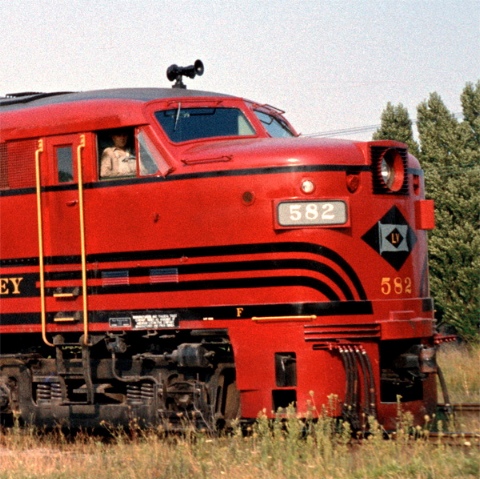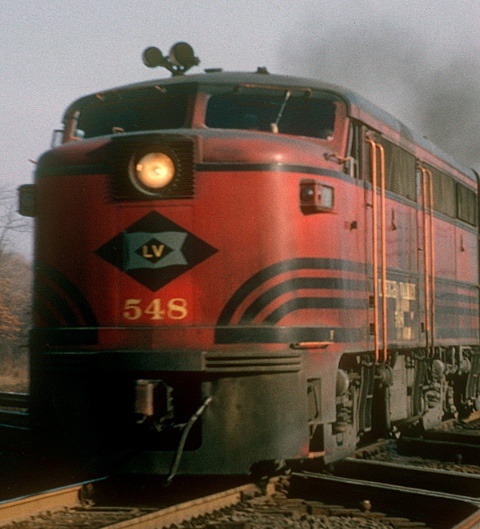The Lehigh Valley Railroad applied a succession of color schemes to its diesel locomotives over the years, and in its final years the Valley was a riot of colors, with five different schemes coexisting. This page presents a history of the color schemes used, their time periods, and a review of the colors applied to models by the model manufacturers, available from model paint manufacturers, and recommended as custom mixes by LV modelers and fans.
A Note on Color
Depending on the time of day and the quality of the light, paint can take on a variety of hues to the human eye: cooler under a clear blue sky and open shade, warmer in the rays of the setting sun. To a large extent, our brains “adjust” the color that we see, and unless we are paying particular attention, we don’t notice these differences. Photographic film records a smaller range of colors than the eye can see, and does not make the automatic color adjustments that our vision does. A red locomotive photographed under a clear blue winter sky, with snow on the ground, appears much darker and cooler on film than the same loco photographed late in the day in summer sunlight. Add to that the varying characteristics of color films, and you have the makings of endless controversy. Kodachrome tends to emphasize red, while Ektachrome emphasizes blue, and Ansochrome tends to highlight yellow. EMD obtained their paint from Dupont, while Alco purchased theirs from Pratt & Lambert. Even when fresh, these paints might have presented different appearances depending on the quality of the light in which they were viewed, since modern color matching technology was not available in the 1950s, and paints matched under one light source can appear quite different under another light source. (That’s the reason modelers are always advised to paint under the same lighting that they use on their layout!) Different brands of paint also may have weathered differently, so what started out as the same color could look quite different before two locomotives got their next repaint, in about seven years if maintenance was not deferred for economic reasons.
One more color complication is introduced when we display color photos on a computer monitor! The photos on this web site come from many sources, so in addition to the effects mentioned above, the characteristics of the scanners and software used to digitize the photos, and the characteristics and settings of your color monitor will affect what you see. No image appearing here can be guaranteed to be completely accurate in terms of color!
Finally, it is often the case that the exact paint used on the prototype does not look realistic on a model! This is known as the “scale effect.” A red automobile will look brighter when it is 5 feet away than it does when it is 435 feet away. Because of this effect, looking at an HO scale model from 1 foot away is like looking at the prototype 87 feet away. Military modelers typically add 10-20% light gray or white to simulate the effect of distance.
Cornell Red with Black Stripes (Applied 1945 – 1964; lasted on some units, especially switchers, until Conrail)
Fresh out of the shops
This Cornell Red color scheme was originally proposed by EMD’s design department for the FTs, the Valley’s first diesel road units, which were delivered in 1945. It was adopted as the standard color scheme for all units, including new Alco locomotives, starting with the PA1s and FA1s, and all switchers were repainted into this scheme by 1950.
Factory Painted Models
With all the difficulties in deciding exactly what shade is Cornell Red, it’s not surprising that the model manufacturers have been all over the map in their choice of shade. Here’s a roundup of models produced in HO scale, compared to a chip of Cornell Red salvaged from business car 353 by Rich Jahn when it was being refinished.
Model Paints
- Accu-paint AP-9
- Badger Model-flex 16-184
- PollyScale 414360 – very dark, similar to the Proto 2000 factory Cornell Red
- Scale Coat S62
- Scale Coat II S2062
For what it’s worth, here is a collection of mixes recommended by different people over the years.
- 4 parts Floquil Caboose Red and 1 part Floquil Coach green (Jonathan Black)
- 14 parts Floquil Signal Red and 1 part Floquil Conrail Blue (Rich Jahn)According to Rich, this matches the DuPont paint chip for Cornell Red. Stewart Hobbies’ Cornell Red is also matched to this same paint chip, but the mix and Stewart’s color look different to me. One custom painter has told me that Floquil’s colors have changed over the years as they had to modify their paint formulas to meet environmental regulations, so that might explain the difference.
- 5 parts Polly S Caboose Red and 1 part Polly S Conrail Blue (Rich Jahn)PollyScale colors may not give the same results, since the paint formulas are different from the old Polly S.
- 10 parts Floquil Signal Red, 4 parts Floquil Conrail Blue and 3 parts Floquil Grime ( John Pursell)This mix is matched to the typical faded color seen on units that still wore the original Cornell Red / Black Stripes scheme in the 1970s. Using Grime produces a nice faded effect, while adding white makes it too pink, according to John.
“Yellow Jacket” delivery scheme for Alco C420s (1964)
Rich Jahn reports that the prototype paints were DuPont #5248 Yellow and DuPont #57704 Gray.
“Snow Bird” or “White Elephant” delivery scheme for Alco C628s (1964)
Two batches of C628s were delivered in the same scheme – white with black trim.
Tuscan Red (Applied 1964 – 1972; lasted on some units until Conrail)
This is the same color as used by the PRR, and is available from many model paint suppliers.
“Late” Cornell Red (Applied 1971 – 1976)
In December 1971, four GP38ACs were delivered to the LV in a new paint scheme, Cornell Red with a single yellow stripe and large gothic lettering. The “new” Cornell Red was probably intended to be the same color as the original Cornell Red, but may have differed slightly because of changes in availability of color pigments and the paint manufacturing process over a quarter of a century. The new scheme was adopted as the standard for all repaints, with some variations, mainly in the use of safety striping. In this photo of two SW8s, taken in May 1976, the “original” Cornell Red on 253 is at least 12 years old, since all repaints after 1964 were done in Tuscan, while the “new” Cornell Red on 273 is only two years old, having been repainted in April 1974. Considering how long 253’s paint has weathered, and the known tendency of the original Cornell Red paint to become darker and more purple as it aged, the colors are quite close!
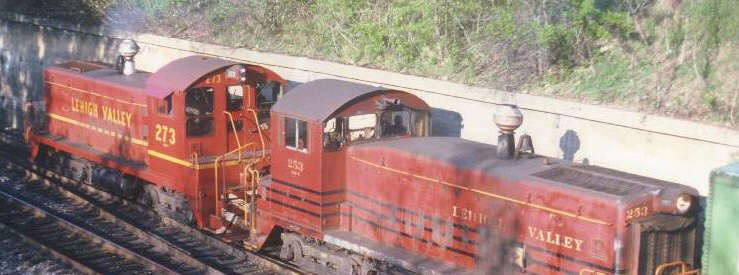 From the Houser collection; used with permission.
From the Houser collection; used with permission.
Rich Jahn reports that the prototype paint color is DuPont #C6537A.
- 1 part PollyScale LV Cornell Red, 1 part PollyScale Caboose red and 1 part ModelFlex Signal Red (Tom Haag)
- 2 parts Accu-paint Cornell Red, 1 part Floquil Caboose Red and 1 part Floquil Signal Red (Jim Six)
- 2 parts Accu-paint Cornell Red, 1 part Vermillion, and 1 part Santa Fe red (Ralph DiBlasi)
- Floquil DH10 Caboose Red, with a small amount of Floquil Signal Red as needed to match photos (Greg Marling)
- Model Master Guard Red (Chuck Huthmaker)
- 20 parts Badger Model-Flex SF Red, 1 part Badger Model-Flex E-L Maroon (Scott Neuner). Scott says that this mix matches the Atlas factory paint on their HO scale U23Bs.
Safety Orange for handrails and grabs on locomotives and cabooses (1963 – 1976)
- Scalecoat II Rio Grande Orange (Mark Nolan)
HOWEVER:
DECALS
Diesels in Tuscan schemes
Accu-cals 7052
Intended mainly for late Cornell Red Alco C628s, this sheet includes the correct nose stripes for 630, which was the only C628 to be painted Tuscan, and which did not have the black diamond on the nose. Appears to be quite accurate.
Diesels in Late Cornell Red scheme
Accu-cals 7052
Intended for Alco C628. Appears to be quite accurate. Includes black diamonds with both wide and narrow white outlines, stripes for nose and pilots, and stripes for 630, which was painted Tuscan and did not have the black diamond on the nose.
Herald King L-850
Intended for GP38AC, GP38-2 & U23B, but may also usable on others. Check photos and pay close attention to the crossbars on the lettering, since they vary from one type of locomotive to another, and perhaps even from unit to unit. The color is a very deep yellow, too close to orange for my taste. White stripes are on clear background, so can be used over black or red.
Herald King L-851
Intended for switchers.
Herald King L-852
Intended for C628, but also usable on RS11 and possibly others. Check photos and pay close attention to the crossbars on the lettering, since they vary from one type of locomotive to another, and perhaps even from unit to unit. White stripes are on clear background, so can be used over black or red. Large black diamond with wide white outline. Large white flags for C628.
Microscale 87-855
Intended for GP38AC, GP38-2 & U23B, but possibly usable on others as well. Check photos and pay close attention to the crossbars on the lettering, since they vary from one type of locomotive to another, and perhaps even from unit to unit. The color appers to be closer to the LV’s yellow than the Herald King sets. Black diamonds with white and black outline. Black and white stripes.
Diesels in other schemes
Accu-cals 7051
Covers the Alco C628 in the Snowbird scheme. Captures the general look quite well, but the thinner diagonal strokes on the V, A and Y don’t show quite enough difference from the thick strokes. Two styles of G are provided, and again both capture the general look, but the “round” G is almost a perfect circle, rather than slightly compressed as on the prototype.
Microscale 87-880
Intended for C420 in Yellow Jacket scheme & C628 in Snowbird scheme. Yellow lettering for C420 appears to be slightly off, with crossbars of the E, G and H in the wrong positions. Black lettering for C628 has similar errors, but they are not quite so noticeable, because the prototype cross bars on E and H were not as far off center. This sheet does not quite capture the style of the G, either, but that varied somewhat from locomotive to locomotive. The slightly thinner right hand strokes of the V and Y are also missing, but because the lettering is so thin to begin with, is not so noticeable. This sheet has the correct red flags for both the C420 (flying to the rear on both sides) and the C628 (flying left to right on both sides).
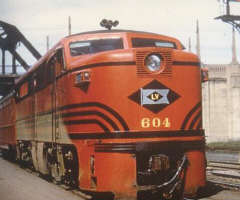
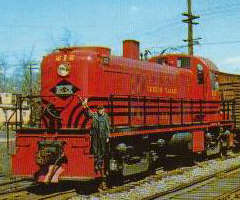
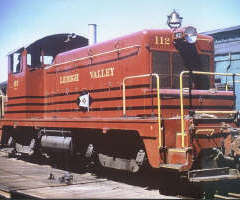
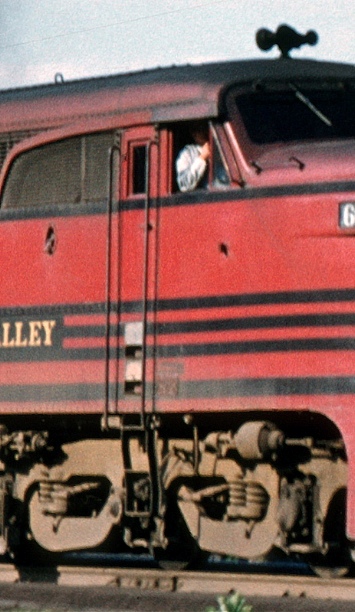 A 1958 photo shows the handrails are black
A 1958 photo shows the handrails are black